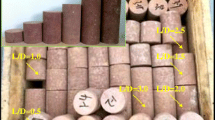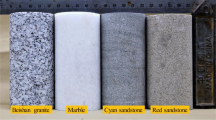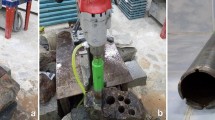Abstract
Uniaxial compressive properties of rocks are very important for designing and constructing engineering projects. Based on the available standards for determining these properties, high quality core specimens with proper geometry are needed. In many cases, the standard specimens, especially in clay-bearing, fractured, and weathered rocks, are always not able to be prepared. On the other hand, in some natural conditions, rocks with different size, shape, and cross-section are undergoing uniaxial compressive loading. Therefore, in order to evaluate the uniaxial compressive strength dependency behaviors of rocks on the shape and cross-section of tested specimens, some marble specimens with three different cross-sections, including circular, square, and rectangular, as well as four different shape ratios (height to diameter/width ratio) of 0.5, 1, 2, and 3 were prepared and tested. Axial and lateral strains, acoustic emission (AE), and camera photographs were recorded during the tests. Rock strength behavior was evaluated based on several stress thresholds, including crack closure stress (σcc), crack initiation stress (σci), damage stress (σcd), and peak stress (σucs). The results indicated that σcc was not dependent on the cross-sectional shape of specimens. With increasing shape ratio, σcc gradually increased, while σcd and σucs greatly decreased, and σci remained at a constant value. The cross-sectional shape effect became operative when r was less than or equal to 1. Moreover, the values of σcd and σucs of rectangular prism specimens and square prism specimens are lower than those of cylindrical specimens, indicating that the unstable crack propagation of prism specimens occurs earlier. The difference gap of σcd and σucs between specimens with different cross-sectional shapes was dramatically decreased with increasing shape ratio. The AE and camera recorded data indicated that the fracture modes of rectangular and square prism specimens are more likely to change from shearing to slabbing fracture when the shape ratio decreased from 3 to 0.5. The main crack developed surface turned from wide surface to narrow surface with the shape ratio of rectangular prism specimens changing from 3 to 1 and 0.5. The research results are of referential meaning to the design of pillars in underground hard rock mines.










Similar content being viewed by others
References
Aggelis DG (2011) Classification of cracking mode in concrete by acoustic emission parameters. Mech Res Commun 38(3):153–157
American Society for Testing and Materials (ASTM) (1994) Annual book of ASTM standards, vol 04.08. ASTM, Philadelphia, PA, USA
American Society for Testing and Materials (ASTM) (2000) American Society for Testing and Materials. Annual book of ASTM standards, vol 04.08. ASTM, Philadelphia, PA, USA
Bieniawski ZT (1967) Mechanism of brittle fracture of rock, parts I, II and III. Int J Rock Mech Min Sci Geomech Abstr 4(4):395–430
Bieniawski ZT (1968) The effect of specimen size on compressive strength of coal. Int J Rock Mech Min Sci Geomech Abstr 5(4):325–335
Bordia SK (1971) The effect of size and stress concentration on the dilatancy and fracture of rock. Int J Rock Mech Min Sci Geomech Abstr 8(6):629–640
Bruning T, Karakus M, Nguyen GD, Goodchild D (2018) Experimental study on the damage evolution of brittle rock under triaxial confinement with full circumferential strain control. Rock Mech Rock Eng 51(11):3321–3341
Chinese standard (2013) Standard for test methods of engineering rock mass. GB/T 50266-2013 (in Chinese)
Damjanac B, Fairhurst C (2010) Evidence for a long-term strength threshold in crystalline rock. Rock Mech Rock Eng 43(5):513–531
Das MN (1986) Influence of width/height ratio on post-failure behaviour of coal. Int J Min Geol Eng 4(1):79–87
Dhir RK, Sangha CM (1973) Relationships between size, deformation and strength for cylindrical specimens loaded in uniaxial compression. Int J Rock Mech Min Sci Geomech Abstr 10(6):699–712
Du K, Li XB, Li DY, Weng L (2015) Failure properties of rocks in true triaxial unloading compressive test. Trans Nonferrous Metals Soc China 25(2):571–581
Du K, Tao M, Li XB, Zhou J (2016) Experimental study of slabbing and rockburst induced by true-triaxial unloading and local dynamic disturbance. Rock Mech Rock Eng 49(9):3437–3453
Eberhardt E, Stead D, Stimpson B, Read RS (1998) Identifying crack initiation and propagation thresholds in brittle rock. Can Geotech J 35:222–233
Esterhuizen GS, Dolinar DR, Ellenberger JL (2011) Pillar strength in underground stone mines in the United States. Int J Rock Mech Min Sci 48(1):42–50
Feng F, Li X B, Rostami J, Peng D X, Li D Y, Du K (2019) Numerical investigation of hard rock strength and fracturing under polyaxial compression based on Mogi-Coulomb failure criterion. Int J Geomech 19(4): 04019005–1. https://doi.org/10.1061/(ASCE)GM.1943-5622.0001352
Frew DJ, Forrestal MJ, Chen W (2001) A split Hopkinson pressure bar technique to determine compressive stress-strain data for rock materials. Exp Mech 41:40–46
Gong FQ, Luo Y, Li XB, Si XF, Tao M (2018) Experimental simulation investigation on rockburst induced by spalling failure in deep circular tunnels. Tunn Undergr Space Technol 81:413–427
Green SJ, Perkins RD (1968) Uniaxial compression tests at varying strain rates on three geologic materials. In: Proceedings of the 10th symposium on rock mechanics, Austin, Texas, May 1968, pp 35–54
Hawkins AB (1998) Aspects of rock strength. Bull Eng Geol Environ 57:17–30
Hoek E, Brown ET (1980) Underground excavations in rock. Institution of Mining and Metallurgy, Stephen Austin and Sons Ltd., London, pp 154–158
Hong L, Li XB, Ma CD, Yin TB, Ye ZY, Liao GY (2008) Study on size effect of rock dynamic strength and strain rate sensitivity. Chin J Rock Mech Eng 27(3):526–533 (in Chinese)
Hudson JA, Crouch SL, Fairhurst C (1972) Soft, stiff and servo-controlled testing machines: a review with reference to rock failure. Eng Geol 6(3):155–189
International Society for Rock Mechanics (ISRM) (2007) The complete ISRM suggested methods for rock characterization, testing and monitoring: 1974–2006. In: Ulusay R, Hudson JA (eds) Suggested methods prepared by the commission on testing methods. ISRM, compilation arranged by the ISRM Turkish National Group, Kozan Ofset, Ankara, Turkey
Jaeger JC, Cook NGW, Zimmerman R (2009) Fundamentals of rock mechanics. Wiley, Hoboken, NJ
Jamshidi A, Nikudel MR, Khamehchiyan M, Sahamieh RZ (2016) The effect of specimen diameter size on uniaxial compressive strength, P-wave velocity and the correlation between them. Geomech Geoeng 11(1):13–19
Kahraman S, Alber M (2006) Estimating unconfined compressive strength and elastic modulus of a fault breccia mixture of weak blocks and strong matrix. Int J Rock Mech Min Sci 43(8):1277–1287
Košťák B, Bielenstein HU (1971) Strength distribution in hard rock. Int J Rock Mech Min Sci Geomech Abstr 8(5):501–521
Li DY, Li CC, Li XB (2011) Influence of sample height-to-width ratios on failure mode for rectangular prism samples of hard rock loaded in uniaxial compression. Rock Mech Rock Eng 44(3):253–267
Li G, Tang CA, Liang ZZ (2017) Development of a parallel FE simulator for modeling the whole trans-scale failure process of rock from meso- to engineering-scale. Comput Geosci 98(C):73–86
Li XB, Feng F, Li DY, Du K, Ranjith PG, Rostami J (2018) Failure Characteristics of Granite Influenced by Sample Height-to-Width Ratios and Intermediate Principal Stress Under True-Triaxial Unloading Conditions. Rock Mech and Rock Eng 51:1321–1345
Liang CY, Zhang QB, Li X, Xin P (2016) The effect of specimen shape and strain rate on uniaxial compressive behavior of rock material. Bull Eng Geol Environ 75(4):1669–1681
Liu BC, Zhang JS, Du QZ, Tu JF (1998) A study of size effect for compression strength of rock. Chin J Rock Mech Eng 17(6):611–614 (in Chinese)
Martin CD (1997) Seventeenth Canadian geotechnical colloquium: the effect of cohesion loss and stress path on brittle rock strength. Can Geotech J 34(5):698–725
Martin CD, Maybee WG (2000) The strength of hard-rock pillars. Int J Rock Mech Min Sci 37(8):1239–1246
Martin CD, Christiansson R (2009) Estimating the potential for spalling around a deep nuclear waste repository in crystalline rock. Int J Rock Mech Min Sci 46(2): 219–228
Mogi K (1966) Some precise measurements of fracture strength of rocks under uniform compressive stress. Rock Mech Eng Geol 4:41–55
Mogi K (2007) Experimental rock mechanics. Taylor & Francis, London, pp 6–11
Nicksiar M, Martin CD (2012) Evaluation of methods for determining crack initiation in compression tests on low-porosity rocks. Rock Mech Rock Eng 45(4):607–617
Nicksiar M, Martin CD (2013) Crack initiation stress in low porosity crystalline and sedimentary rocks. Eng Geol 154(2):64–76
Obert L, Duvall WI (1967) Rock mechanics and the design of structures in rock. Wiley, London
Pan YS, Wei JM (2002) Experimental and theoretical study on size effect on strain softening of rock materials. Chin J Rock Mech Eng 21(2):215–218 (in Chinese)
Paterson MS, Wong TF (2005) Experimental rock deformation—the brittle field. Springer-Verlag, Berlin Heidelberg, pp 1–63
Rojat F, Labiouse V, Kaiser PK, Descoeudres F 2009 Brittle rock failure in the steg lateral adit of the lötschberg base tunnel. Rock Mech Rock Eng, 42(2):341–359
Tao M, Zhao HT, Li XB, Li XA, Du K (2018) Failure characteristics and stress distribution of pre-stressed rock specimen with circular cavity subjected to dynamic loading. Tunn Undergr Space Technol 81:1–15
Thuro K, Plinninger RJ, Zah S, Schutz S (2001) Scale effects in rock strength properties. Part 1: unconfined compressive test and Brazilian test. In: Proceedings of the ISRM regional symposium, EUROCK 2001, rock mechanics—a challenge for society, Espoo, Finland, June 2001, pp 169–174
Tuncay E, Hasancebi N (2009) The effect of length to diameter ratio of test specimens on the uniaxial compressive strength of rock. Bull Eng Geol Environ 68(4):491–497
Unlu T, Yilmaz O (2008) Investigation of the shape effect on the uniaxial compressive strength of the intact rock. In: Türk N, Deliormanlı AH, Kıncal C (eds) Proceedings of the 9th regional rock mechanics symposium, Izmir, Turkey, pp 121–141
Wang H, Liu D, Cui Z, Cheng C, Jian Z (2016) Investigation of the fracture modes of red sandstone using XFEM and acoustic emissions. Theor Appl Fract Mech 85:283–293
Xu Y, Cai M (2017) Numerical study on the influence of cross-sectional shape on strength and deformation behaviors of rocks under uniaxial compression. Comput Geotech 84:129–137
Yang SQ, Xu WY, Su CD (2005) Study on statistical damage constitutive model of rock considering scale effect. Chin J Rock Mech Eng 24(24):4484–4490 (in Chinese)
Zhang QB, Zhao J (2014) A review of dynamic experimental techniques and mechanical behaviour of rock materials. Rock Mech Rock Eng 47(4):1411–1478
Zhao XG, Cai M, Wang J, Li PF (2015) Strength comparison between cylindrical and prism specimens of Beishan granite under uniaxial compression. Int J Rock Mech Min Sci 76:10–17
Zipf RK (2001) Pillar design to prevent collapse of room-and-pillar mines. In: Hustrulid WA, Bullock RC (eds) Underground mining methods: engineering fundamentals and international case studies. Society for Mining, Metallurgy, and Exploration, Littleton, CO, pp 493–511
Acknowledgements
The work described in this paper was supported by the National Natural Science Foundation of China (grant no. 51774326) and the Hunan Provincial Natural Science Foundation of China (grant no. 2017JJ3390), as well as by the Fundamental Research Funds for the Central Universities of Central South University (grant no. 2017zzts794).
Author information
Authors and Affiliations
Corresponding author
Rights and permissions
About this article
Cite this article
Du, K., Su, R., Tao, M. et al. Specimen shape and cross-section effects on the mechanical properties of rocks under uniaxial compressive stress. Bull Eng Geol Environ 78, 6061–6074 (2019). https://doi.org/10.1007/s10064-019-01518-x
Received:
Accepted:
Published:
Issue Date:
DOI: https://doi.org/10.1007/s10064-019-01518-x




